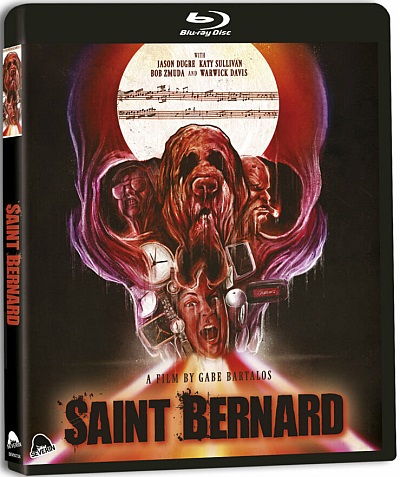So what do I find myself reviewing today? CAPITALISM: A LOVE STORY (2009), the latest muckraking documentary by left-wing gadfly Michael Moore. Gaa!!!
Well, I'm not going to get into politics today because I used up my last good nerve on that stuff years ago. Instead, I'll try to focus on the film's entertainment value and watchability. First off, Moore starts the ball rolling with a promo clip for Hershell Gordon Lewis' BLOOD FEAST, with Bill Kerwin warning young, impressionable, and heart-attack-prone viewers to steer clear of the impending feature. That's worth some nostalgia points right there. Unfortunately, it makes me want to watch BLOOD FEAST.
Moore's film, however, is pretty scary itself. It's a scathing indictment of how capitalism and free enterprise in America have long been corrupted by the rich and powerful for their own greedy purposes while us Joe and Jane Six-Packs get the shaft. Part of Moore's method is to show us some of those awesome 50s educational films that are so delightfully square and full of crewcuts and horn-rims, and contrast their chipper naivete' with contemporary horror stories of families getting thrown out of their homes, factory workers being fired en masse, and airline pilots on food stamps.

The old "American dream vs. American nightmare" stuff works every time, especially when it's accompanied by dramatic Beethoven music. Moore's goal is to make you scared, sad, and outraged, and also to make you laugh--an emotional smorgasbord. With deft editing of stock film and music, plus his own manipulative documentary footage and slanted observations, the filmmaker creates a chunky visual goulash that would have Bela Lugosi shouting "Pool da strink!"
Naturally, Moore is able to gleefully avail himself of clips from old Ronald Reagan movies, which is convenient since most of our Republican presidents didn't start out as B-movie actors. So we get to see Ronnie whipping out his six-shooter on the unions or slapping a woman around while Moore chides "Take that, feminists!" or whatever. Not exactly a strict documentary approach, but as comedy it scores on a MST3K level. Later, a clip of George W. Bush giving a doom-and-gloom speech on the economy is made hilarious with the digital addition of screaming people fleeing in terror in the background while the White House is beseiged by earthquakes, tornadoes, and monsters. Funny stuff, in an Adult Swim sort of way.
Interview segments are interspersed throughout, some (politicians, financial experts) more relevant that others (actor Wallace Shawn). Moore also recruits a few religious figures to solemnly explain to us why capitalism itself is inherently evil--refraining, as one might guess, from consulting any who might express a differing view. Most effective are the accounts of downtrodden victims of a crumbling economy, and a few minutes spent with his own father on the site of a razed factory back in Flint, Michigan where he once worked adds to the often melancholy tone.

Moore goes for the heartstrings in these segments, plucking away with sad accounts of personal tragedy and hardship caused by corporate greed. You can't help but be moved by shots of little kids crying and people finding out the hard way that refinancing their homes probably wasn't such a good idea when the cops start breaking the door down. Some revelations are guaranteed to outrage, such as the concept of "Dead Peasants" insurance, which is the practice of taking out life-insurance policies on employees so that a company profits by their death. Recaps of high-profile scandals and evidence of deep-rooted government corruption are also sure to make you feel either angry or depressed, or both. Not to mention powerless.
But then, of course, we're back to the classic Michael Moore schtick of him trying to wedge a film crew through the front door of a gleaming corporate fortress so that some fat, overworked security shlub will have to come out and deal with them. This is what Michael Moore fans love to see--the cavorting troublemaker "sticking it to" the bad guys with nought but his disruptive and rebelliously unkempt presence. "I'm making a citizen's arrest!" he yells into a megaphone at a building. Or he backs a rented armored truck up to the door and demands that the fat cats cowering under their desks return their billions in bailout money to the taxpayers. Or simply wraps the building in yellow crime scene tape.
Moore got a taste for this kind of street theater with ROGER AND ME, and, useless as it may be, loves to perform it for us while "documenting" it. And, of course, it's fun to watch in the same way it was fun whenever David Letterman used to go down to GE headquarters to stir up a little trouble with the suits.
The DVD from Anchor Bay is in 1.78:1 anamorphic widescreen and Dolby Digital 5.1 with English and Spanish subtitles. Extras include a substantial ten featurettes and two trailers.
The picture begins with a "what if"--what if we'd listened to Jimmy Carter (aka "Debbie Downer") back in 1979?--and ends with the comforting assurance that President Obama will wisely and selflessly strive to put things right again. Do I buy everything Michael Moore says? No. Does CAPITALISM: A LOVE STORY accurately expose the evil machinations of a bunch of greedy, insanely wealthy bastards who play with our economy, and our lives, like it was their own private crap game? Yes. Does it make me want to abandon capitalism and embrace socialism? No. Is it entertaining? Well, to be honest, I was really bummed out after I watched it, but that was the point. And it was funny at times, and generally very well-crafted. And it made me think. I think I want to watch BLOOD FEAST.















































